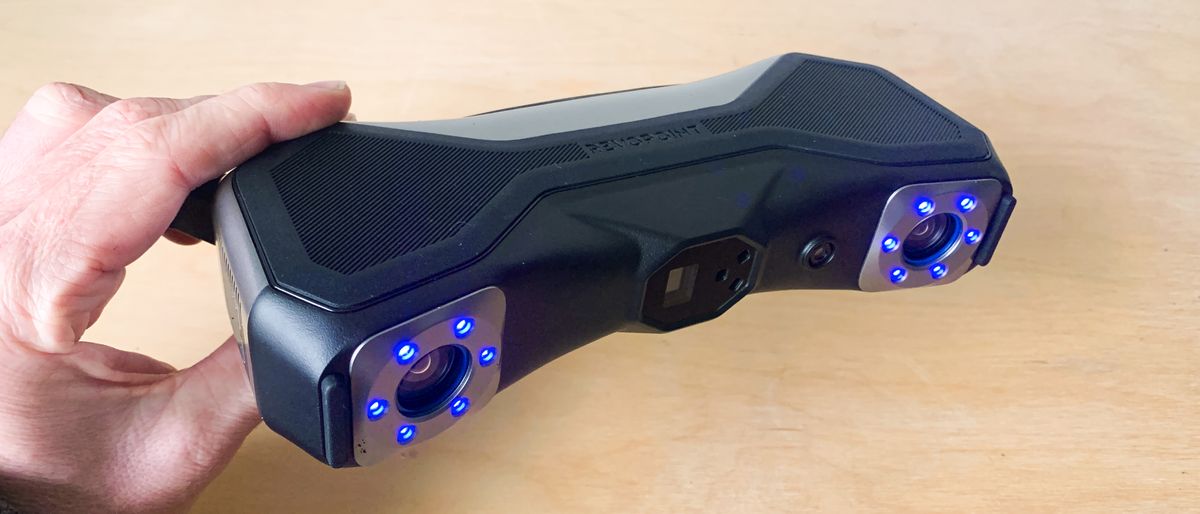Our Verdict
The MetroX scanner from Revopoint is a well-built and full-field structured light 3D scanner offering a fully featured blue laser line. These types of laser scanning modes deliver accurate results, although more reflective objects will still require scanning spray. I loved the automated turntable due to the easy workflow and the guaranteed accurate results that you get.
For
- Fast full-field mode
- Versatile scanning modes
- Automated Turntable Mode
Against
- Doesn’t completely remove the need for scan spray
- Not suitable for large objects
- Too expensive for hobbyists
Why you can trust Creative Bloq
If you own one of the best 3D printers, then it won’t be long before you start thinking about purchasing one of the best 3D scanners as well. When paired together, 3D scanners and 3D printers are excellent tools to enable creatives to generate bespoke creations and print replicas of existing objects. In the past decade, technology has become so advanced that hobbyists are now able to produce the same, if not better, results that have previously been restricted to professionals.
One of the latest 3D scanners on the market is the Revopoint MetroX, and I’ve recently been putting this device through its paces so that you can decide whether it’s a perfect fit for you. The MetroX is a hybrid 3D scanner that combines the power of a multi-line laser with a 62-line full-field blue structured light scanner.
Revopoint claims that the industrial-grade 14 cross lines laser scanning mode is adept at efficiently scanning shiny metal and black surfaces. It’s quite a claim considering how difficult scanners have historically found these types of surfaces. In our review, we’ll go through unboxing, offer some informed feedback on its performance, and consider who this scanner is ideally suited for.
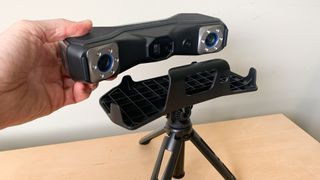
Revopoint MetroX Scanner review: Key specs
Object size: | Small to medium-sized objects |
Single capture: | 160 x 70 mm at 200 mm |
Scanning speed: | 7 high-powered parallel blue laser lines / 14 crossed blue laser lines |
Single-frame accuracy: | 0.03mm |
Dimensions: | 209 × 88 × 44 mm |
Weight: | 508g |
Compatible OS: | Windows, macOS |
Price
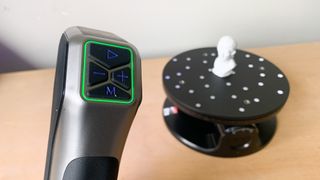
The Revopoint MetroX has a high price tag of £959 / $1,099. Though at this price point, it’s a little more affordable than the Creality CR-Scan Raptor. If you want something more budget-friendly than the MetroX, then you could go for the Revopoint Mini 2 instead, although it’s not as feature-rich as the model we're reviewing.
Unboxing
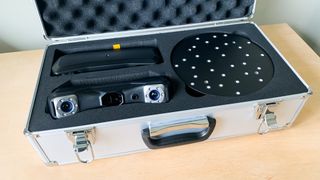
The MetroX scanner and all the accessories ship in a fairly sizable, durable, metal carry case. This immediately tells you that the MetroX is not a scanner that is thrown in a bag for on-the-go scanning but is instead a professional solution that you take with you to a planned location. As a result, there is an abundance of foam padding to ensure every item contained inside is kept free from damage while in transit.
The contents of the case include the scanner, wrist strap, USB cable, power adapter, dual-axis turntable, tripod, scanner cradle, calibration board, and sample bust. I was also sent a separate marker block kit which can be purchased separately.
The scanner itself measures 209 x 88 x 44mm in size and is 508g in weight. Despite the lightweight nature of the scanner, the MetroX is surprisingly robust and durable. The thick plastic construction limits frame distortion when the scanner is in use while rubber pads help protect the overall unit from damage. I especially like the two rubber pads that are on the front face of the scanner which guarantee no damage will come to the faces of the lenses when the unit is placed on a flat surface.
The MetroX features a set of rubber buttons for controlling the scanning process. These buttons are nice and firm so pressing any of them is both predictable and reliable. The USB-C port is recessed by around 100mm which helps to ensure the port stays free from damage as well as protecting the cable from accidentally wobbling out mid-scan. Every element of the design appears to be thought-through and well-considered.
Aside from the scanner and cables, the MetroX also ships with a tiltable turntable. Unlike most other turntables, this one can be controlled automatically through the Revo Scan software. This allows for one-click scans and brings a nice unity between the scanner and the turntable. It’s also worth noting that colour scanning is unfortunately only available in auto turntable mode.
Performance
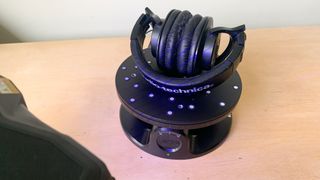
The MetroX scanner adopts two main data capture techniques: full-field, and laser. Despite Revopoint being at the forefront of developing this type of technology, even this company is not able to produce bullet-proof products without fault.
The MetroX is a case in point. During beta testing and then at first release, there were reports of a number of problems relating to capture accuracy and the generation of rogue scan points. Thankfully, Revopoint has managed to solve most of these issues through Revo Scan updates, demonstrating the company’s commitment to providing reliable and trustworthy scanning solutions.
My experience of the scanner varies between the two different capture techniques and I was particularly interested in finding out whether I needed scanning spray to 3D capture objects. Let’s dive in and take a look at each mode in turn.
First up, full field. This single-shot technique works by capturing an object’s surface all at once, rather than point-by-point. This has the benefit of faster and more efficient 3D data capture, something that is also generally true with the MetroX. Despite this approach working with both feature tracking and global marking, the former is definitely the preferred option. It appears to be the only way of getting usable and predictable results.
I also tested the full-field mode with both handheld and tripod support to see if this made a difference to the capture accuracy. I found it did. With handheld, there were some issues with the loss of tracking and rogue points but hardly any of these issues when working with a tripod and the automated turntable. The latter is a surefire way to guarantee the best results.
Scanning shiny and black objects in full field mode unfortunately still requires scanning spray in most cases. The technology is not yet able to fully and reliably interpret highly reflective surfaces and therefore map them accurately. This was a little disappointing but not entirely unexpected. Don’t be throwing that scanning spray away just yet.
I then moved onto the laser mode which requires marker dots to track surfaces. Given the number of markers you will use up after a few weeks or months of scanning, we highly recommend buying a separate marker kit. The process of laser scanning takes a little bit of getting used to but it’s not overly complicated. The two-step process is different to feature-based scanning techniques and can stump beginners if they’re not careful.
The actual scanning time is longer than the full field because data is only captured along the laser lines. I therefore recommend moving around an object slowly and in a measured fashion. You won’t get good results if you adopt an unplanned scattergun approach.
Similarly to full field mode, the scanning of flat black objects is much more reliable than super shiny surfaces. Again, keeping that scanning spray handy is best.
Who's it for?
With 3D scanners becoming more common than ever, we are seeing an increasing range of different products appearing within each type of application. The MetroX is specifically targeted, although not exclusively, to professional users involved in reverse engineering objects. The blue light scanner has the added benefit of being able to scan reflective objects and therefore negate the need for scanning spray.
The scanner is best for capturing small to medium objects with a range of between 10mm x 10mm x 10mm up to 1m x 1m x 1m. Larger objects will need to be broken up and merged afterwards.
This is a serious beast for serious professionals and hobbyists. If you only dabble in 3D printing or creating miniatures, then you’ll want something more entry-level.
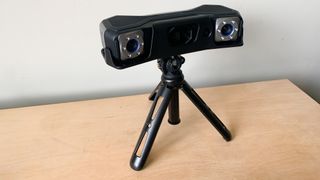
Buy it if...
- You want a professional grade 3D scanner
- You’re tired of using scanning spray
- You scan a lot of reflective objects
Don't buy it if...
- You need an entry-level solution
- You’re on a budget
- This is your first 3D scanner
out of 10
The MetroX scanner from Revopoint is a well-built and full-field structured light 3D scanner offering a fully featured blue laser line. These types of laser scanning modes deliver accurate results, although more reflective objects will still require scanning spray. I loved the automated turntable due to the easy workflow and the guaranteed accurate results that you get.

Paul is a digital expert. In the 20 years since he graduated with a first-class honours degree in Computer Science, Paul has been actively involved in a variety of different tech and creative industries that make him the go-to guy for reviews, opinion pieces, and featured articles. With a particular love of all things visual, including photography, videography, and 3D visualisation Paul is never far from a camera or other piece of tech that gets his creative juices going. You'll also find his writing in other places, including Creative Bloq, Digital Camera World, and 3D World Magazine.
You must confirm your public display name before commenting
Please logout and then login again, you will then be prompted to enter your display name.
